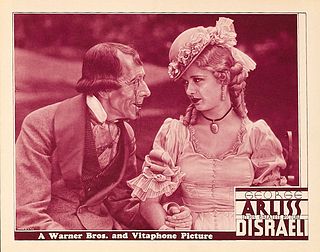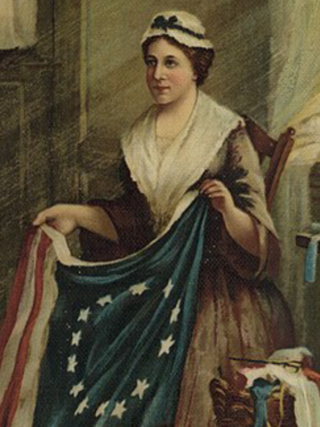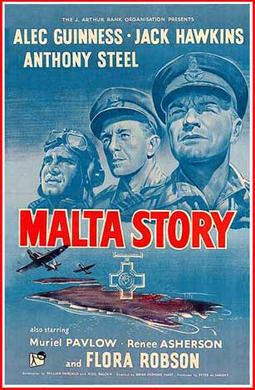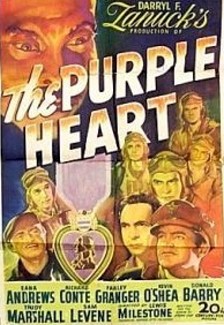
Disraeli is a 1929 American pre-Code historical film directed by Alfred E. Green, released by Warner Bros. Pictures, Inc., and adapted by Julien Josephson (screenplay) and De Leon Anthony (titles) from the 1911 play Disraeli by Louis N. Parker.

The Black Pirate is a 1926 American silent action adventure film shot entirely in two-color Technicolor about an adventurer and a "company" of pirates. Directed by Albert Parker, it stars Douglas Fairbanks, Donald Crisp, Sam De Grasse, and Billie Dove. In 1993, The Black Pirate was included in the annual selection of 25 motion pictures to be added to the National Film Registry of the Library of Congress, being deemed "culturally, historically, or aesthetically significant."

Elizabeth Griscom Ross, also known by her second and third married names, Ashburn and Claypoole, was an American upholsterer who was credited by her relatives in 1870 with making the second official U.S. flag, accordingly known as the Betsy Ross flag. Though most historians dismiss the story, Ross family tradition holds that General George Washington, commander-in-chief of the Continental Army and two members of a congressional committee—Robert Morris and George Ross—visited Mrs. Ross in 1776. Mrs. Ross convinced George Washington to change the shape of the stars in a sketch of a flag he showed her from six-pointed to five-pointed by demonstrating that it was easier and speedier to cut the latter. However, there is no archival evidence or other recorded verbal tradition to substantiate this story of the first U.S. flag. It appears that the story first surfaced in the writings of her grandson in the 1870s, with no mention or documentation in earlier decades.

The submarine film is a subgenre of war film in which most of the plot revolves around a submarine below the ocean's surface. Films of this subgenre typically focus on a small but determined crew of submariners battling against enemy submarines or submarine-hunter ships, or against other problems ranging from disputes amongst the crew, threats of mutiny, life-threatening mechanical breakdowns, or the daily difficulties of living on a submarine.

Beverly of Graustark is a 1926 American silent romantic comedy film directed by Sidney Franklin and starring Marion Davies, Antonio Moreno, and Creighton Hale. The film's screenplay was written by Agnes Christine Johnston based on the novel by George Barr McCutcheon, and set in the fictional land of Graustark. The film features a final sequence in Technicolor. It was the first film by Sidney Franklin for MGM.

Beau Geste is a 1939 American adventure film starring Gary Cooper, Ray Milland, Robert Preston, Brian Donlevy, and Susan Hayward. Directed and produced by William A. Wellman, the screenplay was adapted by Robert Carson, based on the 1924 novel of the same title by P. C. Wren. The music score was by Alfred Newman and cinematography was by Theodor Sparkuhl and Archie Stout.

Malta Story is a 1953 British war film, directed by Brian Desmond Hurst, which is set during the air defence of Malta during the Siege of Malta in the Second World War. The film uses real and unique footage of the locations at which the battles were fought and includes a love story between a RAF reconnaissance pilot and a Maltese woman, as well as the anticipated execution of her brother, caught as an Italian spy. The pilot is loosely based on Adrian Warburton; the Maltese woman's brother is based on Carmelo Borg Pisani, who was executed in 1942.

The Purple Heart is a 1944 American war film, produced by Darryl F. Zanuck, directed by Lewis Milestone, and starring Dana Andrews, Richard Conte, Don "Red" Barry, Sam Levene and Trudy Marshall. Eighteen-year-old Farley Granger had a supporting role.

The Betsy Ross flag is an early design for the flag of the United States, which is conformant to the Flag Act of 1777 and has red stripes outermost and stars arranged in a circle. These details elaborate on the 1777 act, passed early in the American Revolutionary War, which specified 13 alternating red and white horizontal stripes and 13 white stars in a blue canton. Its name stems from the story, once widely believed, that shortly after the 1777 act, upholsterer and flag maker Betsy Ross produced a flag of this design.

The Scarlet Coat is a 1955 American historical drama and swashbuckler in Eastmancolor and CinemaScope released by Metro-Goldwyn-Mayer, produced by Nicholas Nayfack, directed by John Sturges. It stars Cornel Wilde, Michael Wilding, George Sanders, and Anne Francis. The film is based upon the events in the American Revolution in which Benedict Arnold offered to surrender the fort at West Point to the British in exchange for money.

Daddy's Gone A-Hunting is a 1925 American silent drama film directed by Frank Borzage based upon a play by Zoë Akins, with adaptation by Kenneth B. Clarke. The film brought together Vitagraph leading lady Alice Joyce and English actor Percy Marmont after his success with If Winter Comes. This is the only film either of the main stars made for MGM. The film was remade in 1931 as Women Love Once. A print survives in the Národní filmový archiv.

Heritage of the Desert is a 1932 American Pre-Code Western film directed by Henry Hathaway and starring Randolph Scott and Sally Blane. This was the first movie that Henry Hathaway directed.

Beware of Pity is a 1946 British romantic drama film directed by Maurice Elvey and starring Lilli Palmer, Albert Lieven and Cedric Hardwicke. It is based on the 1939 novel of the same name by Stefan Zweig. A paraplegic young baroness mistakes compassion for love. The film's costumes were designed by Cecil Beaton. It was made by Two Cities Films at Islington Studios. The film was not a great popular success outside the Soviet Union.

Arthur John Maude was an English actor, screenwriter, and film director.

Out of the Chorus is a lost 1921 American silent drama film starring Alice Brady and directed by Herbert Blache. It was produced and distributed by Paramount offshoot Realart Pictures.

Betsy Ross is a surviving 1917 American silent historical film starring Alice Brady and produced and distributed by her father William A. Brady.

Captain Courtesy is a lost 1915 American silent drama film directed by Phillips Smalley and Lois Weber based upon a novel by Edward Childs Carpenter. The film stars Dustin Farnum, Courtenay Foote, Winifred Kingston, Herbert Standing, and Jack Hoxie. The film was released on April 19, 1915, by Paramount Pictures.

Secret Enemies is a 1942 American drama film directed by Benjamin Stoloff and written by Raymond L. Schrock. The film stars Craig Stevens, Faye Emerson, John Ridgely, Charles Lang, Robert Warwick, and Frank Reicher. The film was released by Warner Bros. on September 17, 1942.

The Undercurrent was a 1919 American silent directed by Wilfrid North, produced by Guy Empey, distributed by Select Pictures. It is based on a story by Arthur Guy Empey and though fictional, is considered a sequel to Over the Top which was a 1918 movie loosely based on his autobiographical book of the same name about his own experiences in the British Army in World War I. The New York City premier was held at the Capitol Theatre and was attended by General John J. Pershing who was in New York City for the International Trade Conference of 1919.
Buffalo Bill's Last Fight is a 1927 MGM silent fictionalized film short in two-color Technicolor. It was the second short film produced as part of Metro-Goldwyn-Mayer's "Great Events" series. As with the first film in the series, The Flag: A Story Inspired by the Tradition of Betsy Ross, this film continued the series' original intent to focus on events from American history. Ultimately, only one other short was shot which stuck to this format; the other films in the series featured historical events with a European or Asian focus.



















